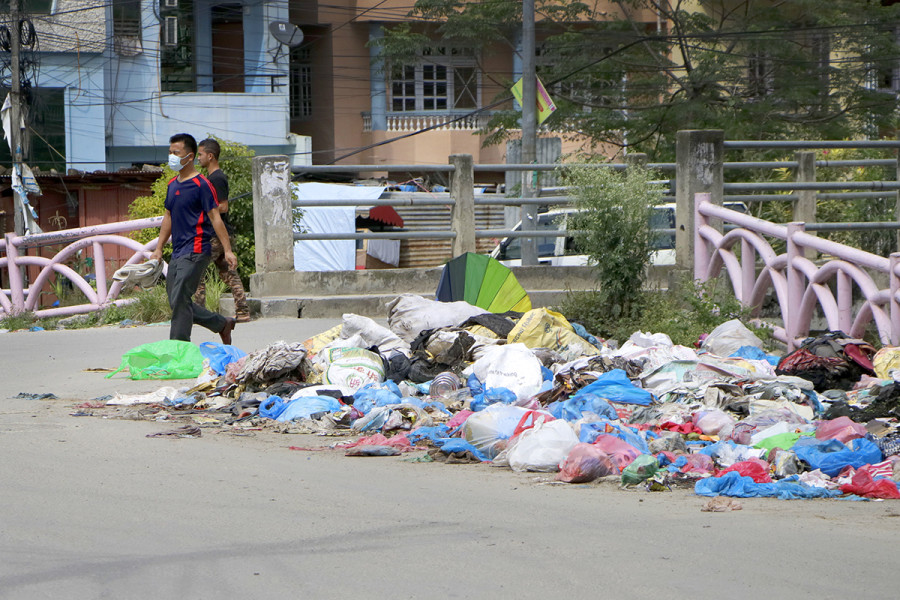Columns
Managing waste sustainably
Federal and provincial governments should collaborate with local levels to address the problem.
Ganesh Paudel
With the rise in living standards, the waste problem in Kathmandu has become ever more complex. Depending on the socioeconomic and cultural conditions, cities can have different varieties of waste. However, they can broadly be classified into four categories: Municipal solid waste, sewage waste, waste from production processes and commercial waste, and construction and demolition waste (C&D waste). To date, C&D waste is barely a problem for municipal governments in Nepal because it can be easily dumped nearby or has a certain value that can be traded for economic gain. Sewage waste is not treated and managed properly and is directly sent into rivers in Kathmandu, which has profound environmental effects and requires a huge investment to tackle it.
The third type is waste from production processes and commercial waste, which are more hazardous and should be treated with special care. Unfortunately, municipal and federal governments seem unaware about the proper treatment of this waste. As a result, they are mixed up with municipal solid waste, collected, and disposed of. The fourth type is municipal solid waste, which contains household, organic, packaging, bulky, and commercial waste. They are mixed, collected, transported and dumped either openly or at landfills.
Among the various types of waste, municipal waste is undoubtedly the largest in the world due to its complexity and the intensity of resources required to manage it. The negative impacts of municipal waste are pervasive and affect every economy, regardless of socioeconomic conditions. This pollutes our rivers, clogs sewers, transmits diseases, emits harmful gasses, increases air pollution, excretes leachate, pollutes soil, and affects the nation’s economic progress. However, this effect is more pronounced in developing countries like ours than in developed ones, and many factors can be blamed for it. Ineffective use of technology, unavailability of technical staff, lack of knowledge, and inadequate resource allocation are the main causes of the waste management problem. Thus, there is a growing need for intelligent and effective solutions to decouple economic growth from finite resources. And only a prudent leader with a multidimensional vision can achieve the result.
Waste separation challenges
In June 2022, the Kathmandu Metropolitan City Office issued a notice for waste segregation in biodegradable and non-biodegradable categories. The city office even threatened its residents with a fine if they were found violating the notice. However, the city authorities seem to be avoiding the general principle of the rule of law, i.e., no law shall be introduced retroactively, causing its citizens to lose confidence in the government. Furthermore, it is the duty of the city government to analyse the principle of proportionality before introducing any decree or law. For better results, the city government should answer questions about legitimacy, suitability, necessity, and adequacy before formulating laws.
Waste separation itself is a vast topic, as municipal waste contains a wide variety of the waste that can be separated and used. As per the World Bank Report 2018, municipal solid waste in low-income countries consists of 53 percent organic waste, 6 percent paper, 7 percent plastic, and the rest are textiles, metals, glass, and other categories. The organic waste, if separated properly, can be turned into compost or thermally recovered; the paper can be recycled; plastic and glass can be reused and recycled; textiles can be reused; and metals have value. Seeing the nature of its scale and the intensity of resources required, no local bodies can manage it solely. That is why the federal and provincial governments should work hand-in-hand with local governments across the country to deal with it sustainably. For example, the federal government can work on policy formation, the provincial government should allocate potential sites for waste management, and the local government can sort, transport, and dispose of the waste.
Problem with our mindset
There is no proper allocation of resources, identification of appropriate waste management sites, treatment procedures after segregation, long-term planned horizon, environmental impact analysis, or economic impact analysis. Yet we make decisions that may have short-term solutions that will have severe implications in the long run. Either we do not have enough knowledge or we are in a state of self-proclaimed expertise, claiming to know all. Among all, the long-term planned horizon is one of the critical processes that helps confine the decision-making process, making it less scattered, especially in unstable political circumstances like ours. A proper plan envisions the probable problem in the future and foresees the solution to it. So a long-term plan is a must for a permanent solution to the perennial waste problem.
Furthermore, the allocation of sufficient resources ensures the smooth operation of the system. The waste management site provides an alternative for treatment and disposal; a long-term planned horizon confines the decision-making process, making them less scattered, especially in unstable political circumstances. The environmental impact analysis highlights the potential threat to the environment and suitable compensation for it. An economic impact analysis provides insight into the economic viability of the project.
Deposit refund system
This scheme is widely used across developed nations, Germany being considered a pioneer. Under this scheme, consumers pay a deposit when purchasing bottle items, depending on the type of product, which is returned when the bottles are returned to a retail shop. For example, imagine buying a bottle of water from a retail grocery store in Kathmandu that costs Rs20 (12–13 rupees at wholesale price). The consumer consumes the water in it, and the bottle is now a waste. Imagine that the government formulated a policy that states that the cost of a water bottle is Rs20, but it also includes the cost of an empty bottle, which is Rs2. Will you see a bottle on the street now? Obviously, there should be a mechanism to return the bottles, and corporate social responsibility funds (CRS funds), which are mostly wasted by creating artificial turf-like structures in Lainchaur, can be mobilised for it. This is just an example of how waste can be managed. As every country has a unique situation and problem, the solution should also be sought locally, and proper research should be done before implementing it.
Because of the intensity and complexity of the problem, no solution can be a panacea. It would be unjust and imprudent to say that the technology and solution that are successful in one context will have the same result in another. However, there is no harm in learning the technology and methods used to solve the problem. In fact, it can be used as guidance in finding context-based solutions. Policymakers and stakeholders should consider innovative solutions.




 7.12°C Kathmandu
7.12°C Kathmandu















